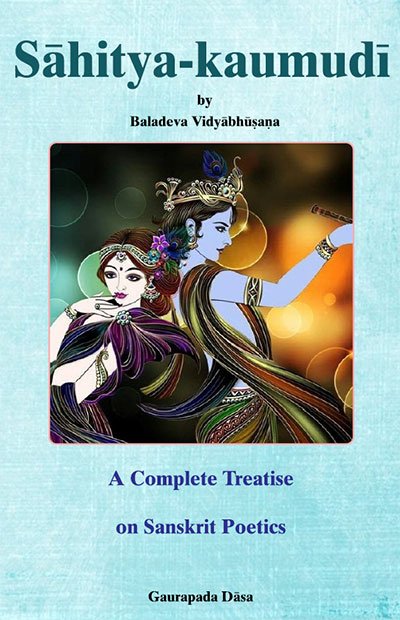Sahitya-kaumudi by Baladeva Vidyabhushana
by Gaurapada Dāsa | 2015 | 234,703 words
Baladeva Vidyabhusana’s Sahitya-kaumudi covers all aspects of poetical theory except the topic of dramaturgy. All the definitions of poetical concepts are taken from Mammata’s Kavya-prakasha, the most authoritative work on Sanskrit poetical rhetoric. Baladeva Vidyabhushana added the eleventh chapter, where he expounds additional ornaments from Visv...
Text 7.69
यत् तु,
yat tu,
This is a counterexample of abhavan-mata-yoga,
nindatānena sādhūnāṃ vṛndāni vacasā tava |
baddha-spardhāpi mad-vāṇī vāṇīśvara vilajjate ||
nindatā—which is criticizing; anena—by this [speech]; sādhūnām—of saintly persons; vṛndāni—the multitudes; vacasā—by the speech; tava—of yours; baddha-spardhā—[my speech,] whose rivalry is engaged; api—although; mat-vāṇī—my speech; vāṇī-īśvara—O master of speech; vilajjate—feels ashamed.
Great orator, my speech, engaged in rivalry with yours, feels ashamed of your words which criticize saintly persons.
ity atra vāṇīśvarācārya-nindāyāṃ prayuktāyāḥ sādhu-nindāyā vacasā sahāsambandhād abhavan-mata-yogatety uktam, tan na, vaco-nindā-mukhena tan-nindāyā vaidagdhyādhikya-vyañjitvāt.
Here it is wrong to conclude the following: “The fault of abhavanmata-yoga occurs in this verse because there can be no semantic connection with the orator’s words since speech cannot possibly feel ashamed.” There is no abhavan-mata-yoga here because by criticizing the words, the criticism is directed at the orator, and that is suggestive of a high degree of cleverness.
Commentary:
The poetic expression is valid by upacāra (metaphorical usage). Here Baladeva Vidyābhūṣaṇa reiterates Viśvanātha Kavirāja’s attack on Mammaṭa’s opinion on the topic.[1]
Viśvanātha Kavirāja gives this example:
anena chindatā mātuḥ kaṇṭhaṃ paraśunā tava |
baddha-spardhaḥ kṛpāṇo’yaṃ lajjate mama bhārgava ||[Rāma speaks to Paraśurāma:] “Descendant of Bhṛgu, My sword, engaged in competition, feels ashamed of your axe, which sliced your mother’s throat[2] ” (Mahāvīra-caritam) (Sāhitya-darpaṇa).
Viśvanātha Kavirāja elaborates:
atra bhārgava-nindāyāṃ prayuktasya mātṛ-kaṇṭha-cchedana-kartṛtvasya paraśunā sambandho na yukta iti prācyāḥ. paraśu-nindā-mukhena bhārgava-nindādhikyam eva vaidagdhyaṃ dyotayatīty ādhunikāḥ,
“In regard to this verse, the ancients hold this opinion: “A connection between the axe and the doership, referred to in criticizing Paraśurāma, of cutting the mother’s throat is wrong.” The moderns, however, say this: “The very excess in criticizing Paraśurāma by criticizing the axe is suggestive of cleverness”” (Sāhitya-darpaṇa 7.8).
The question regards the suitability of this virodha ornament (semblance of a contradiction) (10.127).
Footnotes and references:
[1]:
[2]:
On the order of his father, Paraśurāma killed his mother, but immediately afterward Jamadagni, Paraśurāma’s father, brought her back to life at Paraśurāma’s request (Bhāgavatam 9.16.6-8).
